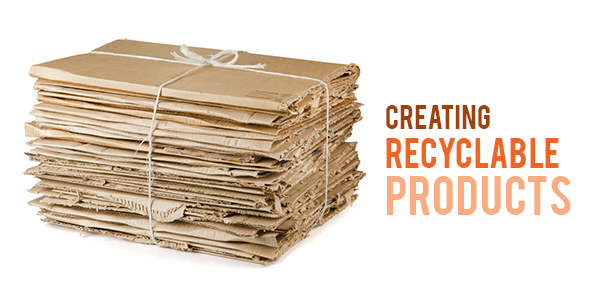2014
The most important question when trying to create a recyclable product is simple: Can this material be recycled?

Recycling cardboard can be a highly advantageous practice for individuals, businesses, and the environment. As one of the most commonly used packaging materials, it is often found in most homes and offices in great quantities and is increasingly collected for recycling, along with plastics and used electronics.
Found in large quantities in just about every area of society, cardboard may not be as big of a concern as plastic, but it can still clog landfills and cause harmful substances to pollute the area.
While cardboard is biodegradable, studies have shown that it does release harmful methane gases as it breaks down. Instead of simply letting cardboard degrade in the landfill naturally, it is both less expensive and more ecologically sound to recycle it when possible.
For those who weren’t raised with a green mind, recycling refers to the process of collecting waste cardboard, breaking it down into its raw materials, and using those materials to make new items.
Unfortunately this process is not possible with every kind of cardboard, making it even more important to recycle those items that can be. Corrugated cardboard – cardboard made with a wavy piece sandwiched between to flat sheets – can be recycled and is often turned into paperboard; the flat, single-sheet cardboard used to make cereal boxes and other similar packaging. Paperboard can also be recycled and is often broken down and recycled many times.
The most common types of cardboard that cannot be recycled are the wax coated pieces used to make beverage containers. These pieces must be coated in wax to prevent liquid from escaping, but the coating renders them unfit for recycling in many places. Pizza boxes with grease inside also can’t be recycled, and the same goes for cardboard that is chemically treated in any way.
When designing a product or packaging for a product, it is important to keep all of these factors in mind so that you can ensure it’s fully recyclable, preventing pollution in our landfills and the overuse of wood products.
Benefits of recycling cardboard include economic concerns such as saving money on disposal costs and selling cardboard to recycling units to get refunded money, as well as environmental concerns such as reducing the amount of trees we cut down. Because cardboard is made with wood products, increasing the amount of cardboard we recycle will also save trees and help the environment flourish!
 Recent Posts
Recent Posts
- 5 Things to Consider When Packaging Food
- How Does Hot Foil Stamping Work?
- 5 Tips for Monochrome Packing
- How To Choose The Right Boxes For Your Business
- What Type of Information Is Legally Required for Package Design?
 Categories
Categories
- Announcements
- Company Information
- Frequently Asked Questions
- General Category
- Goldrich
- Newsletter Articles
- Product News
- Testimonials
Deprecated: Function wp_list_cats is deprecated since version 2.1.0! Use wp_list_categories() instead. in /home/goldpakcom/public_html/wp-includes/functions.php on line 6121
 Archives
Archives
- March 2015
- February 2015
- January 2015
- December 2014
- November 2014
- October 2014
- September 2014
- August 2014
- July 2014
- June 2014
- May 2014
- April 2014
- February 2014
- January 2014
- November 2013
- October 2013
- September 2013
- July 2013
- June 2013
- May 2013
- April 2013
- March 2013

 Proudly Canadian Since 1953
Proudly Canadian Since 1953